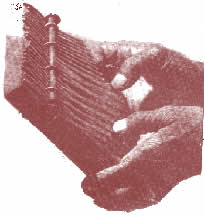Mbira and Shona Spirituality
 Mbira
is the traditional music of the Shona people of Zimbabwe. Its history
dates back more than a thousand years. The music is an extension of the
culture, folklore, wisdom and spirituality of the Shona
people.
Mbira
is the traditional music of the Shona people of Zimbabwe. Its history
dates back more than a thousand years. The music is an extension of the
culture, folklore, wisdom and spirituality of the Shona
people.
The word mbira is also used interchangeably to describe four related concepts:
- The first is a musical instrument with sound producing metal keys.
- The second concept of mbira refers to each individual key.
- The third concept refers to a type of music played on the mbira instrument.
- The fourth and final concept of refers to a family of instruments with similar general features but with different physical configurations, social and religious functions.
Of the different instruments in the mbira family, the most sacred and revered instrument is the 22-key Mbira dzaVadzimu or mbira of the ancestral spirits. Several versions of the same instrument with anywhere between 24 and 28 keys also exist with different tuning.
Shona Beliefs
Shona people believe that death is the passage of the body from one
physical form to another and a separation of spirit from the body to a
higher world of living spirits. Ancestral spirits are a source of comfort
as well as the cornerstone of religious activity for, the living believe
they are protected from worldly harm by their these spirits. Should a
sudden misfortune befall a family, they turn first to their ancestral
spirits for advice, guidance and protection. In many cases a family has
a special spirit, or Mudzimu
which, when properly appeased, speaks directly to the family through a
living spirit medium. In a lengthy and protocol intensive special ceremony,
called Bira
or spirit possession ceremony, special songs, selected from a vast repertoire
of spiritual arrangements, are recalled to welcome a deceased person's
spirit back into the family. Shona prayers, poetry and words of praise
are recited. The mbira and players qualified to play at such occasions,
vana gwenyambira, take center stage as the ultimate vehicle to communicating
with the spirits. The mbira instrument has all the elements required to
"call" the ancestral spirits to participate in the Bira ceremony. The
skill and endurance of mbira players persuades the spirit to possess a
living spirit medium. It is during such a ceremony that ancestral spirits
listen to the concerns of their living family members as well as impart
to them the wisdom, advice, forgotten family customs and protocol to ensure
a healthy and successful family or community. This is the most important
religious
and spiritual function of the instrument in the Shona culture and tradition.
Mbira Construction
The mbira dzavadzimu is a set of carefully shaped and sized
metal keys that produce different tones. The keys are mounted on a rectangular
wooden sound board that acts as a first level amplifier. The metal keys
are mounted to form three registers, ergonomically arranged to facilitate
playing with both thumbs and one forefinger. A metal plate, upon which
bottle caps, or in the old days, snail shells are affixed, is attached
to the front of the sound board. The shells produce a buzzing sound as
they are excited from tones produced by the metal reeds. Unlike western
music where a buzzing sound in considered distortion, and therefore undesirable,
the mbira's buzzing sound is an integral and necessary part of the music.
For the listener, the buzz "tunes out" other stimuli and allows the listener
to hear the mbira rythms. The mbira is mounted inside a calabash resonator
(deze). Bottle caps or snail shells are attached to the mouth of the calabash.
Spiritual Embodiment
The instrument's components, embody many spiritual aspects. The metal
keys are made from smelted iron ore which is dug out from sacred hills
and holy mountains where the Shona chiefs and Shona statesmen are buried.
The keys thus personify the presence of ancestral spirits directly on
the instrument. The sound board, made from a special kind of tree, mubvamaropa,
represents a source of shelter and fuel, basic necessities in everyday
Shona life. The resonator gourd or deze, into which the mbira is mounted
and propped as a second level amplifier is a special type of dried squash,
called Nhangatanga or the first squash, which is a source of food. It
is also used as a water container, dende. In its smaller form and dried,
the nhangatanga squash is used as a drinking gourd, mukombe. The instrument
thus symbolizes the basic elements of everyday life in Shona. The mbira
player adds the final and human dimension to complete a Shona social institution.
The Instrument and its Music
The mbira dzavadzimu is played by plucking the metal reeds with the right
and left thumbs (downwards) and right forefinger (upwards). The music
is a combination of multiple melodies arranged in phrases. Each phrase
is cyclic and so are successive concatenations of phrases. The entire
mbira piece is cyclic. However the ability to substitute carefully positioned
octave or "related" keys not only provides multiple dimensions to the
basic phrase structure of a mbira song but is also testimony to the ingenuity
of its inventors. Two basic parts are associated with each song. The lead
or kushaura and an accompanying part kutsinhira. Played together, the
two interlock. Their interaction produces interwoven intended and unintended
or resultant overtones. These overtones form the essence of the music
as they can establish a multitude of feelings depending on the player
or listener's state on mind. The music can be mesmerizing. It can establish,
for the listener and player alike, a microcosm of serenity inducing a
feeling of amazement, excitement and even a state of sheer catalepsy.